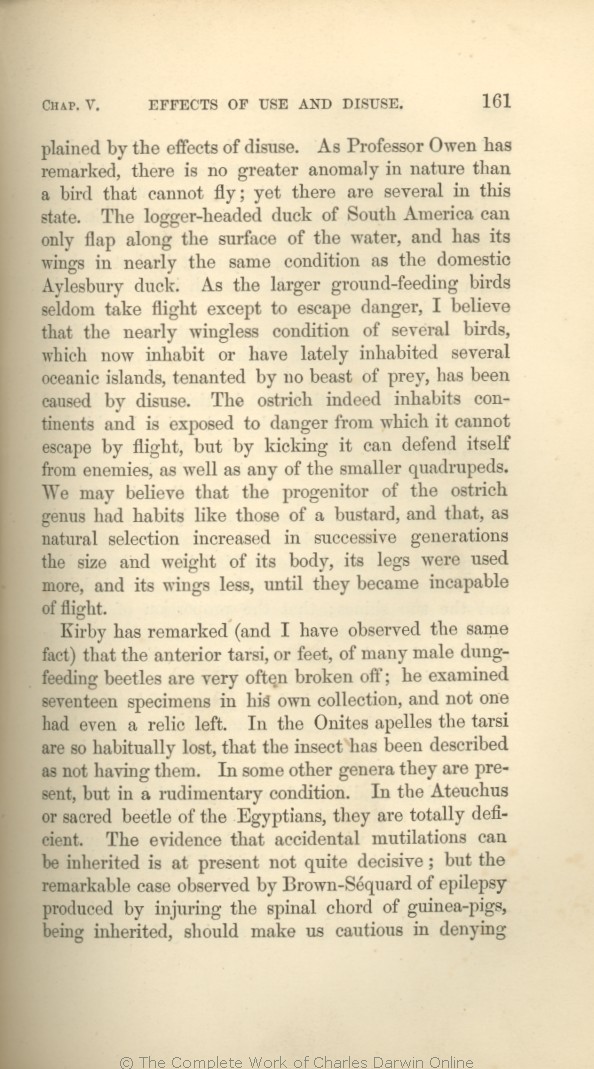by the effects of disuse. As Professor Owen has remarked, there is no greater anomaly in nature than a bird that cannot fly; yet there are several in this state. The logger-headed duck of South America can only flap along the surface of the water, and has its wings in nearly the same condition as the domestic Aylesbury
duck. | duck. 1859 1860 1861 1866 1869 |
| duck: it is a remarkable fact that the young birds, according to Mr. Cunningham, can fly, while the adults have lost this power. 1872 |
| I believe 1859 1860 1861 1866 1869 |
| it is probable 1872 |
| which 1859 1860 1861 1866 1869 | which 1872 |
| inhabit 1859 1860 1861 1866 1869 | | inhabiting 1872 |
| have 1859 1860 1861 1866 1869 | | which 1872 |
| continents 1859 1860 1861 1866 1869 | | continents, 1872 |
| by kicking 1859 1860 1861 1866 1869 | by kicking 1872 |
| from 1859 1860 1861 1866 1869 |
| by kicking its 1872 |
| well 1859 1860 1861 1866 1869 | | efficiently 1872 |
| any 1859 1860 1861 1866 1869 | | many 1872 |
| of the smaller 1859 1860 1861 1866 1869 |
| OMIT 1872 |
| believe 1861 1866 1869 1872 | | imagine 1859 1860 |
| ..... 1861 1866 1869 1872 | | early 1859 1860 |
| genus had 1861 1866 1869 1872 | | had 1859 1860 |
| a 1859 1860 1861 1866 1869 | | the 1872 |
| that, 1866 1869 1872 | | that 1859 1860 1861 |
| natural selection increased in successive generations 1859 1860 1861 1866 1869 |
| OMIT 1872 |
| body, 1859 1860 1861 1866 1869 | | body 1872 |
| its 1859 1860 1861 1866 1869 |
| were increased during successive generations, its 1872 |
|
|
Kirby has remarked (and I have observed the same fact) that the anterior tarsi, or feet, of many male dung-feeding beetles are
very | very 1859 1860 1861 1866 1869 | very 1872 |
| bettle 1866 | | beetle 1859 1860 1861 1869 1872 |
| not quite decisive; 1866 1869 |
| very scanty; 1861 |
| not decisive; 1872 |
| case 1861 1866 1869 | | cases 1872 |
| of epilepsy produced by injuring the spinal chord of guinea-pigs, being inherited, 1861 1866 |
| of inherited epilepsy in guinea-pigs, caused by an operation performed on the spinal chord, 1869 |
| in guinea-pigs, of the inherited effects of operations, 1872 |
| cautious in denying such power. 1866 1869 |
| cautious. 1861 |
| cautious in denying this tendency. 1872 |
|









